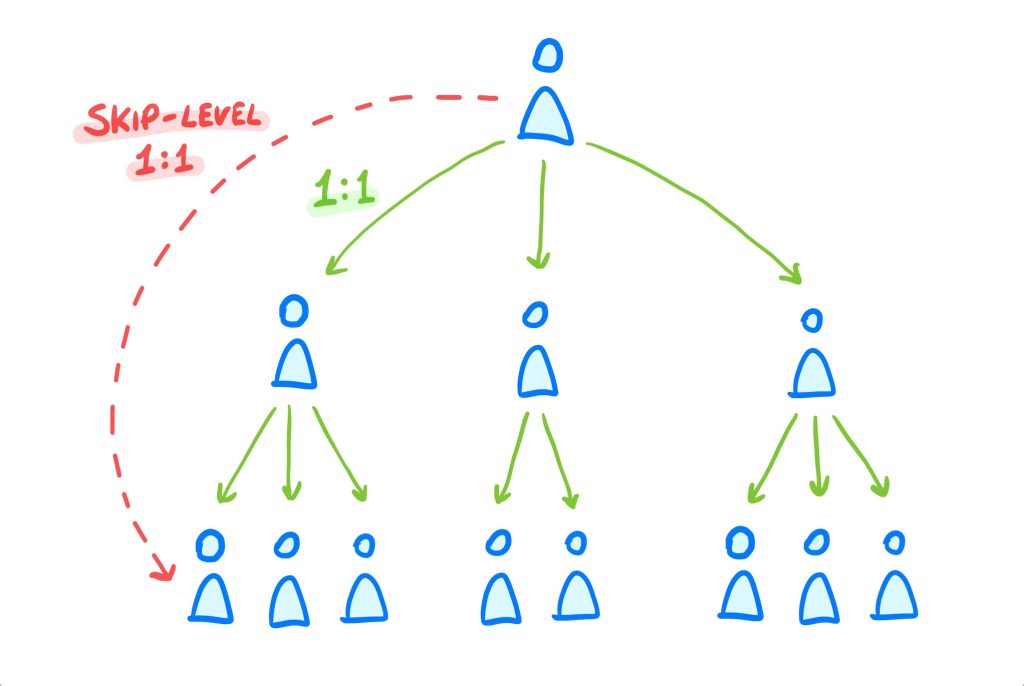One-on-one meeting with an employee: the most important meeting
One-on-one meetings are probably one of the most important tools for successful team management. Some would go as far as to say that there is no other meeting in your schedule that is more important than one-on-one meeting. And you know what? They are probably right. But first, let’s discuss what are these meetings and why are they so important.

One-on-one meeting (or 1:1 meeting) is a regular meeting between the manager and an employee. It can be used for a simple status update (so both the manager and the employee have the latest information regarding the topic of mutual interest), to provide feedback, to address some issue (technical, interpersonal, organisational) or discuss further development needs – these are broad categories where most of the conversations will fit in. They are even useful for developer onboarding! There is no general structure or agenda for these meetings. The main topic will be whatever is the most important for the participants at that moment.
Why is a one-on-one meeting with an employee important?
Well, to successfully manage a team, you need to talk to your team members and maintain an ongoing communication about various aspects of work. I know this may sound simple, but it is way more complex than just having a chat in the hallway or a quick daily stand-up. You need to provide feedback or ask for it, understand their needs or current challenges, help them out if they get stuck. Also, you need to help them grow (both within the company and as a professional). This is done by sharing your knowledge and experiences, providing advice, or pointing them in the right direction.
Addressing any problems is a must
You may also need to address a problem they might have within the company. However, sometimes you won’t be addressing any problems – but you will instead just listen to what they have to say, because maybe they only want to share how they feel or let out a little steam. All these things matter, and they are all important if you want a healthy team.
So, for you as a team leader (or manager), these meetings are important because you can get the high-level overview of what is going on with your team.
And none of this can be accomplished if you do not talk to your team on a regular basis. So, for you as a team leader (or manager), these meetings are important because you can get the high-level overview of what is going on with your team. They can also help you detect issues in the early stage and plan a proper reaction in a timely manner. For your team members, these meetings are important because they get to talk about the things that are the most important to them and seek your support. You both can also track progress towards either performance or career goals. Lastly (and this is probably the most important benefit of having 1:1 meetings) by doing all the things listed above, you are building the trust between the team members and their manager.

Tips on organising a one-on-one meeting with an employee
As you have probably realised, there is a wide range of topics that are being discussed during one-on-one meeting with an employee. Because of this, there is usually no agenda – the agenda is whatever is the most important thing at that moment. Sometimes, however, you might want to set an agenda to discuss a specific topic. For example, one of your team members could ask you to explain the transition to a senior engineer position. You decide that your next meeting is going to be dedicated to that topic and prepare for it in advance. Sometimes it might be you wanting to discuss something very specific with your employee. That can be addressing some issue listed in the performance review, for example. If so, you might want to let that person know in advance.
Frequency of these meetings
At the beginning of this article, we have also mentioned that these meetings should be regular. Usually, one-on-one meeting with an employee happens once a week or once every two weeks. If you wait more than that – for example, once a month – you may end up in a situation where you receive too much information at once. Or you’ll realise that you have missed an opportunity to address some critical issue.
For 1:1 meeting to work, you absolutely need to organise it regularly. Try to stick to the schedule as much as possible. This way you can process the information properly and act when needed. If you absolutely need to move or skip this meeting, always offer an alternative (moving it to some earlier/later time slot or moving it to some other day) – but make sure that the meeting takes place. When it comes to choosing the frequency of these meetings, think about how much could happen during the time between the meetings. If the team works in a very turbulent environment, having 1:1 meetings every week is probably a good idea. If things are a bit less hectic than having 1:1 meetings every two weeks should be fine.
By having a dedicated time slot for discussing important topics, the team members know that they have a chance to do this every week and it’s just between them and their manager.
Managing expectations efficiently
There is also one other problem that is being addressed with having regular one-on-one meetings with an employee – and that is different expectations when it comes to conversation between the team members and their manager. Some people expect that the manager will come to them if he wants to talk or has anything important to say. Others are completely different, and they actively seek to talk to their manager. Some managers also prefer people coming to them (and it might be their managerial style).
Because of this, it is not hard to imagine a situation where a team member has an issue but is not comfortable with raising this to their manager and manager thinking everything’s fine and expecting people to come to him if something is not right (and, I’ve seen this exact situation happening). By having a dedicated time slot for discussing important topics, the team members know that they have a chance to do this every week and it’s just between them and their manager. Some people may still not feel comfortable with having hard conversations, but that is a different problem.
When it comes to organising one-on-one meeting with an employee, I would advise that you always prefer having them in person, rather than online.
The place of one-on-one meeting
I know that many people are working either fully remote or are coming to the office few days a week, but, if possible, try to suggest to your colleagues that you should have 1-on-1 meetings in the office. Things you discuss are important and require care and a lot of trust; they also require precise communication – and being able to share the physical space with the person you are talking to can only help. Nothing beats face to face communication when this type of conversation needs to take place. Of course, if you are not able to do that, having this discussion online is your second-best option. But even then, at least turn on the camera.
However, the office does not have to be the only place where these meetings will happen. Sometimes, change of scenery can be more than welcome and may even have surprising effect on the conversation. So, instead of using only the conference room, you may have lunch together with your colleague. If there’s a nice cafeteria nearby – maybe you can go and grab some coffee together while you discuss some topic? Or you can maybe just go for a walk? Even beating the hell of each other in the latest Mortal Kombat can be a start to a great conversation. Changing the location can improve your focus and make you more comfortable with sharing thoughts, concerns, and ideas. The meeting room can feel too formal and sometimes people may even fear of being overheard [1].
Stop any distractions
Whatever you decide to do, you also need to remember one more thing: no distractions. These types of meetings are one of the mechanisms for building trust – if you mess this up because you answer Slack messages or fidget with your phone while the other person is talking about something that really matters to him or her, you are doing great harm to your relationship. You really need to listen and focus on the conversation. You can (and you should) take some notes, because otherwise, you are almost certainly going to forget some important topic that was brought up during the conversation.

What about meeting notes?
When it comes to notes, there are some guidelines regarding that, too. You should take some notes during the meeting and then organise them once the meeting is over. They will be more than helpful if you want to refresh your memory regarding certain topics that you discussed in the past, or if you want to keep track of some specific goals/milestones that the employee needs to achieve. Keeping some kind of meeting notes is extremely important regardless of the size of your team and mandatory if you manage larger team.
But what should be in these meeting notes? Well, anything that works for you, if you put in enough information. Here is a simple template for organising meeting notes:
- Date: the date when the meeting took place
- Discussion: what was the topic that was discussed? What were the main conclusions?
- Actions taken: Is there anything that you need to do? Is there anything that the employee needs to do?
This simple template can be used each session, for every member of your team. After some time, you would have a nice overview of your meetings, as well as a lot of insights on many important topics. You can simply use a notebook to take notes (in that case, I recommend a special notebook just for this), or you can create notes locally on your laptop, or even use some tools like Google Docs, Obsidian or Notion. Combination of notebook and an online tool could also work – you can use notebook to quickly write down some important notes during the meeting and then later organize and refine them using the online tool. Personally, I use Notion for a lot of personal notes, so it was my choice for meeting notes as well.
Types of one-on-one meetings with employees
Most of the conversations that you will have during 1:1 meetings can be roughly separated in the following categories – the update, the vent, and the disaster.
You will have many different conversations with your team members because everybody is different. People do not share same concerns and motivations; they might behave very differently in the same situation and want different things from their careers. However, despite this, most of the conversations that you will have during 1:1 meetings can be roughly separated in the following categories – the update, the vent, and the disaster. This is not the classification that I came up with – these categories have been described in Michael Lopp’s book “Managing Humans” and I think they give you a pretty good idea of what to expect from 1:1 meeting [2].
The update
This is probably the most common type of meeting, and it is a status update regarding something. It can be anything, really – from “Hey, how’s your research going?”, or “How far did you get with that POC project?”, to checking the progress towards some goal that has been mutually agreed on. Sometimes, there won’t be much to say – simply because not much has happened since the last time you talked. You can prepare a short list of topics in advance and pick one of them if this happens. You can also share some of the issues or challenges that you are facing (that the other person might not be aware of). However, sometimes the update might reveal some very large issue – interpersonal, organizational, or something else – so listen carefully and act accordingly.
The vent
This type of meeting is very different from the update. It’s not about the status, but about a person telling you that they feel upset or frustrated about something. Usually, it is something that this person cares about and that has been bothering them for some time. Because of that, your best course of action is to listen and when you feel that some conclusion has been reached, ask clarifying questions. However, there are also situations when a person just wants to let out a little steam. These situations usually don’t require you to solve the issue – it’s just about finding someone who can listen.
The disaster
When a disaster happens – you will know. The disaster is the explosive (and extremely negative) emotional reaction to a problem. It can often involve yelling, swearing, crying, or even throwing stuff around. It is extremely important that you try to avoid having an emotional reaction of your own (that can even make the situation worse).
Try to be as calm as possible and wait for this extreme emotion to end – because the person on the other side is not themselves. At this state, they are unable to have a reasonable conversation, so you must wait until the storm has passed. Only then you can start figuring out the underlying issue that was the cause of this explosion. Very often, the root cause is the issue that has been neglected for so long, that it basically drove the person crazy. If this is the case, then you really need to think very hard about how you are doing your job – because that is the sign of poor management.
Skip-level 1:1 meetings
Not all one-on-one meetings with an employee have to be between the manager and his direct reports. You can also have a meeting of this type with your manager’s manager. But why would you do that? Here’s a few reasons:
- You need to discuss some things that you can’t properly address with your direct manager. This can be some high-level topic, like strategy, industry trends or better understanding of certain initiatives within the company. However, you might also have an issue with your direct manager that you want to discuss [3].
- Your manager’s manager might want to share some important information or address some specific topic that has been brought to their attention. They can also ask for feedback on how your manager is doing his work. Or even if he supports you properly [3].

Conclusion
In this article, we tried to provide an overview of one-on-one meeting with an employee: what they are, why are they important and some general guidelines when it comes to organising these meetings. However, there are still many topics that were not covered, but that will probably come up at some point (some of the examples are encouraging people to give their feedback or what to do when the meeting is particularly difficult).
Covering those topics would be outside of scope of this article; the focus here is on the basic principles. You need to be aware why having these one-on-one meetings with an employee is important and why you should do your best to have them regularly. Almost certainly you will make mistakes, but if you are consistent – it will pay off in the long run. You will be more aware of the challenges that your employees are facing, you’ll get to know them better and you might even detect some issue before it’s too late.
References:
- “Managing Humans (3rd edition)”, Michael Lopp, Apress 2016
- Skip Level 1:1s: https://refactoring.fm/p/skip-levels
Let’s start achieving excellence together
Get in touch with our experts today to turn your ideas into reality and accelerate business growth.



